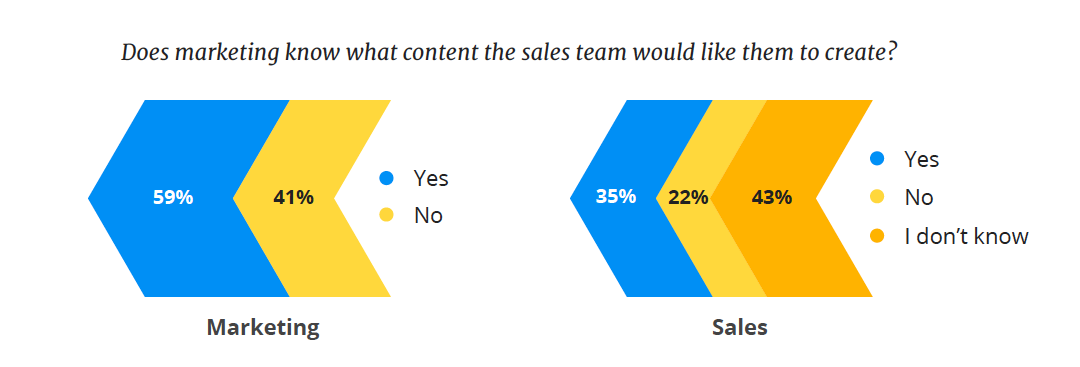Sales and marketing drive growth – period! The term Smarketing (a process of integrating sales and marketing) has become an important topic that it’s the third biggest marketing priority for Software-as-a-Service (SaaS) companies.
So what exactly is sales and marketing alignment, and are you doing it right? To put it simply, it means that you’re taking the proper steps, so both your sales and marketing department are frequently communicating. And to make sure there is mutual accountability on both sides.
However, that won’t happen overnight. Smarketing is a long-term strategy, which you have to continuously evaluate and re-strategize. Also, the bigger the company, the more misalignment occurs. Communication gets more challenging as the number of people grows. And according to Ledgeview, “one-third of marketing and sales teams don’t talk regularly.”
Eventually, misalignment is going to affect growth and revenue. And since there is no denying that sales and marketing are crucial to your company’s success, you must get your teams on the same page.
Below are a few actionable strategies your company can implement to jumpstart the process:
1. Get A Better Understanding Of Your Customers
When it comes to understanding and empathizing with customers, having a buyer persona document is invaluable. It helps businesses find the best ways to acquire clients, better serve their needs, and foster loyalty.
But buyer personas aren’t just for the marketing team; salespeople benefit from the information. By creating a customer profile document for both teams, everyone will be on the same page on who their ideal customers are.
The results are two fold; aligning your sales and marketing teams towards a singular customer journey and avoiding common arguments – the sales team says marketing is getting low-quality leads, for example.
Effective collaboration also means you’ll be able to organize your sales team, schedule, and create the right sales enablement content, along with employing the best systems or technologies for your company.
2. Use Effective Technologies To Foster Marketing And Sales Alignment
The introduction of the right systems and technology would allow you to close the gap between the marketing data you receive on a client and their conversion to leads and loyal customers.
With each of these systems in place and linked inside the company, lead/customer data can be seamlessly moved between marketing and sales. The result is more customer-centric interactions between the two teams as they can collect customer information in advance.
So which technologies should you give priority to when aligning sales and marketing? Below is a breakdown of the most popular sales and marketing alignment technologies used by companies. Source: ifoundries.com
Source: ifoundries.com
The technology used should be connected as an experience – from the consumer’s awareness stage at the start of the funnel, all the way to brand loyalty and customer retention. Using CRM software, which is the most effective technology for sales and marketing alignment, gives you useful data and practical information on your customers.
By having the right technologies in place, you not only have useful customer data, but your marketing and sales team can act in unison based on the latest information. And if the CRM software is cloud-based, updated records can be accessed anywhere, on any connected device.
3. Streamline Communication Between Sales And Marketing
For many businesses, the disconnect between sales and marketing teams is an all too common issue. There are complaints from both sides, playing the blame game once the company’s lack of success becomes apparent.
Salespeople will blame the quality of leads – or lack thereof. People from the marketing department will say the sales team isn’t doing a good enough job of following-up with leads. And the list of complaints goes on and on.
Only 35% of salespeople think marketing knows what they need

Source: uplandsoftware.com
To prevent this from happening in your organization, excellent communication is critical. For example, there needs to be a collaboration between both teams through every stage of the marketing funnel. Whenever marketing produces content to drive leads, sales need to follow-up effectively and promptly. Because the content goes unused, it will not impact sales and conversions as intended.
A regular meeting between marketing and sales provides an excellent opportunity to share thoughts on content development. Both teams can discuss the strategy behind the sales enablement content, and marketing can have a better idea of what drives sales and the marketing messages that customers best respond to.
Also, getting both teams together allows for a brainstorming session to define the company’s terminology clearly. You never know when one team identifies a phrase differently, resulting in miscommunication.
4. Use Service-Level Agreement (SLA) Between Sales And Marketing
Traditionally, a Service-Level Agreement (SLA) serves as a written rule to what customers will come to expect from a service provider. It serves as a benchmark for how the service performs. And what should be done if an agreement does not live up to expectations.
Creating a Service-Level Agreement is a critical step towards achieving synchronization between the two departments for marketing and sales. With an SLA, there are no more unwritten guidelines. You’re able to establish common goals based upon a clear set of rules and using familiar terminology so there would be no misunderstanding. Everything gets measured on every level so it can be improved upon.
So how do you use an SLA to grow your business? There are a few best practices that you can apply in your Service-Level Agreement.
- Marketing agrees to provide a set number of leads to sales in a specific timeframe. The leads’ quality should also be based on specific Key Performance Indicators (KPI), such as website visitor conversions.
- How fast will sales follow-up with the leads from marketing? And at what rate should they close the leads? Agreeing to a certain amount of touchpoints will set the right expectations for those involved without resorting to assumptions.
- Number three is reporting. Keep everyone on the same page by knowing the numbers. By turning the KPIs in your agreements into a dashboard, you can identify critical issues or measure the progress that can be capitalized on. In his way, the two teams can understand essential metrics like lead generation, Marketing Qualified Leads (MQL), and conversion rates.
Conclusion
Marketing isn’t listening to what the sales teams need. Or the sales team doesn’t have a clue how to use the created content properly. If the above is a familiar situation, then addressing the problem is more important than ever. Taking steps and investing time and resources for marketing and sales alignment will allow you to build a cohesive team and position your company for long-term revenue growth.

